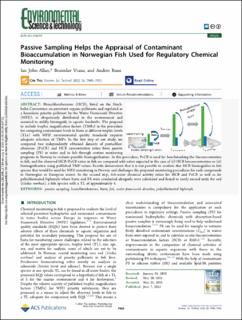| dc.contributor.author | Allan, Ian | |
| dc.contributor.author | Vrana, Branislav | |
| dc.contributor.author | Ruus, Anders | |
| dc.date.accessioned | 2022-07-13T12:47:30Z | |
| dc.date.available | 2022-07-13T12:47:30Z | |
| dc.date.created | 2022-06-15T13:09:10Z | |
| dc.date.issued | 2022 | |
| dc.identifier.citation | Environmental Science and Technology. 2022, 56 (12), 7945-7953. | en_US |
| dc.identifier.issn | 0013-936X | |
| dc.identifier.uri | https://hdl.handle.net/11250/3005071 | |
| dc.description.abstract | Hexachlorobenzene (HCB), listed on the Stockholm Convention on persistent organic pollutants and regulated as a hazardous priority pollutant by the Water Framework Directive (WFD), is ubiquitously distributed in the environment and assumed to mildly biomagnify in aquatic foodwebs. The proposal to include trophic magnification factors (TMFs) in the procedure for comparing contaminant levels in biota at different trophic levels (TLs) with WFD environmental quality standards requires adequate selection of TMFs. In the first step of our study, we compared two independently obtained datasets of pentachlorobenzene (PeCB) and HCB concentration ratios from passive sampling (PS) in water and in fish through routine monitoring programs in Norway to evaluate possible biomagnification. In this procedure, PeCB is used for benchmarking the bioconcentration in fish, and the observed HCB/PeCB ratios in fish are compared with ratios expected in the case of (i) HCB bioconcentration or (ii) biomagnification using published TMF values. Results demonstrate that it is not possible to confirm that HCB biomagnifies in fish species that would be used for WFD monitoring in Norway and challenges the proposed monitoring procedures for such compounds in Norwegian or European waters. In the second step, fish-water chemical activity ratios for HCB and PeCB as well as for polychlorinated biphenyls where biota and PS were conducted alongside were calculated and found to rarely exceed unity for cod (Gadus morhua), a fish species with a TL of approximately 4. | en_US |
| dc.language.iso | eng | en_US |
| dc.publisher | American Chemical Society | en_US |
| dc.rights | Navngivelse 4.0 Internasjonal | * |
| dc.rights.uri | http://creativecommons.org/licenses/by/4.0/deed.no | * |
| dc.title | Passive Sampling Helps the Appraisal of Contaminant Bioaccumulation in Norwegian Fish Used for Regulatory Chemical Monitoring | en_US |
| dc.type | Peer reviewed | en_US |
| dc.type | Journal article | en_US |
| dc.description.version | publishedVersion | en_US |
| dc.rights.holder | © 2022 The Authors | en_US |
| dc.source.pagenumber | 7945-7953 | en_US |
| dc.source.volume | 56 | en_US |
| dc.source.journal | Environmental Science and Technology | en_US |
| dc.source.issue | 12 | en_US |
| dc.identifier.doi | 10.1021/acs.est.2c00714 | |
| dc.identifier.cristin | 2032111 | |
| cristin.ispublished | true | |
| cristin.fulltext | original | |
| cristin.qualitycode | 2 | |

